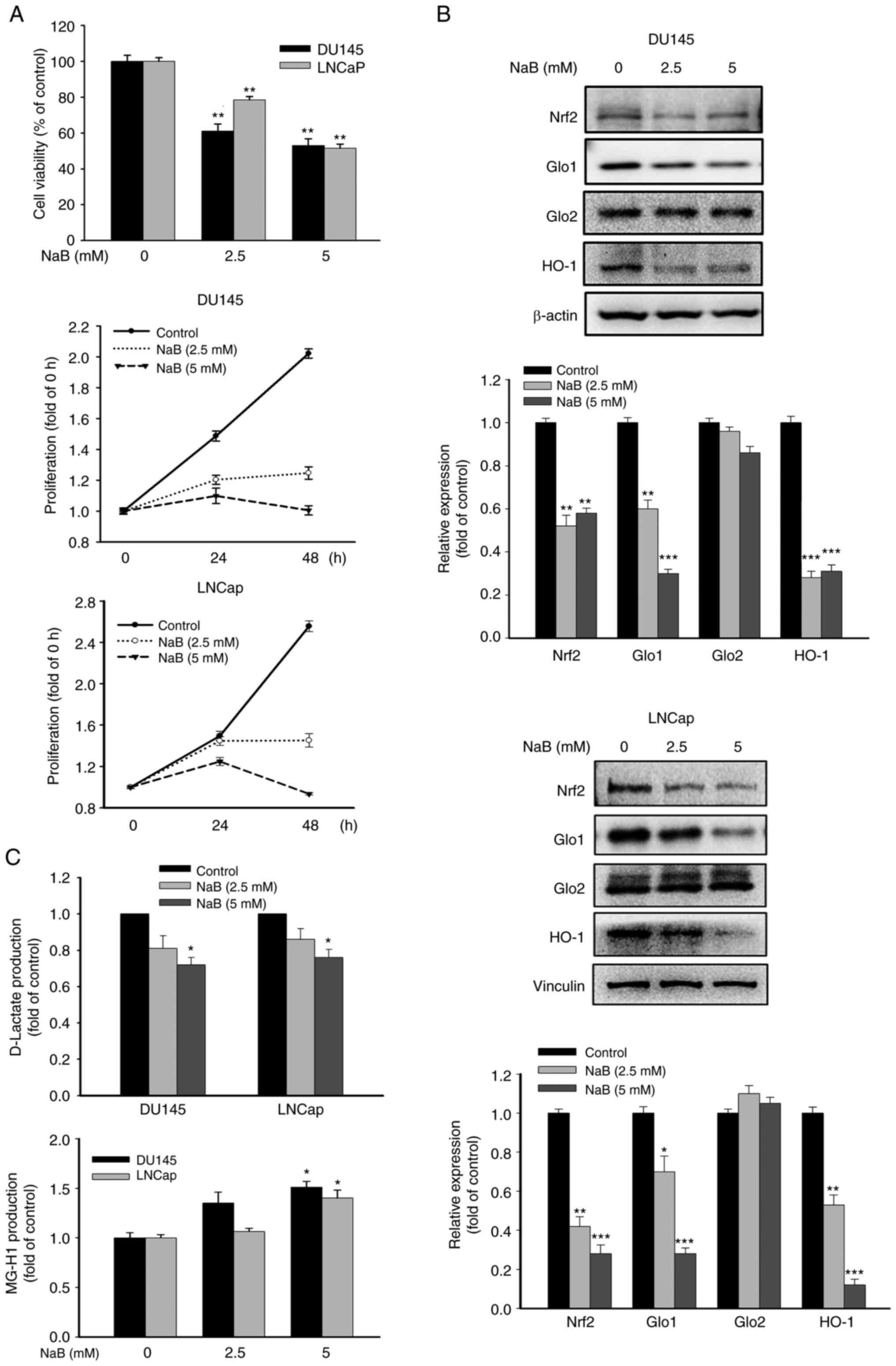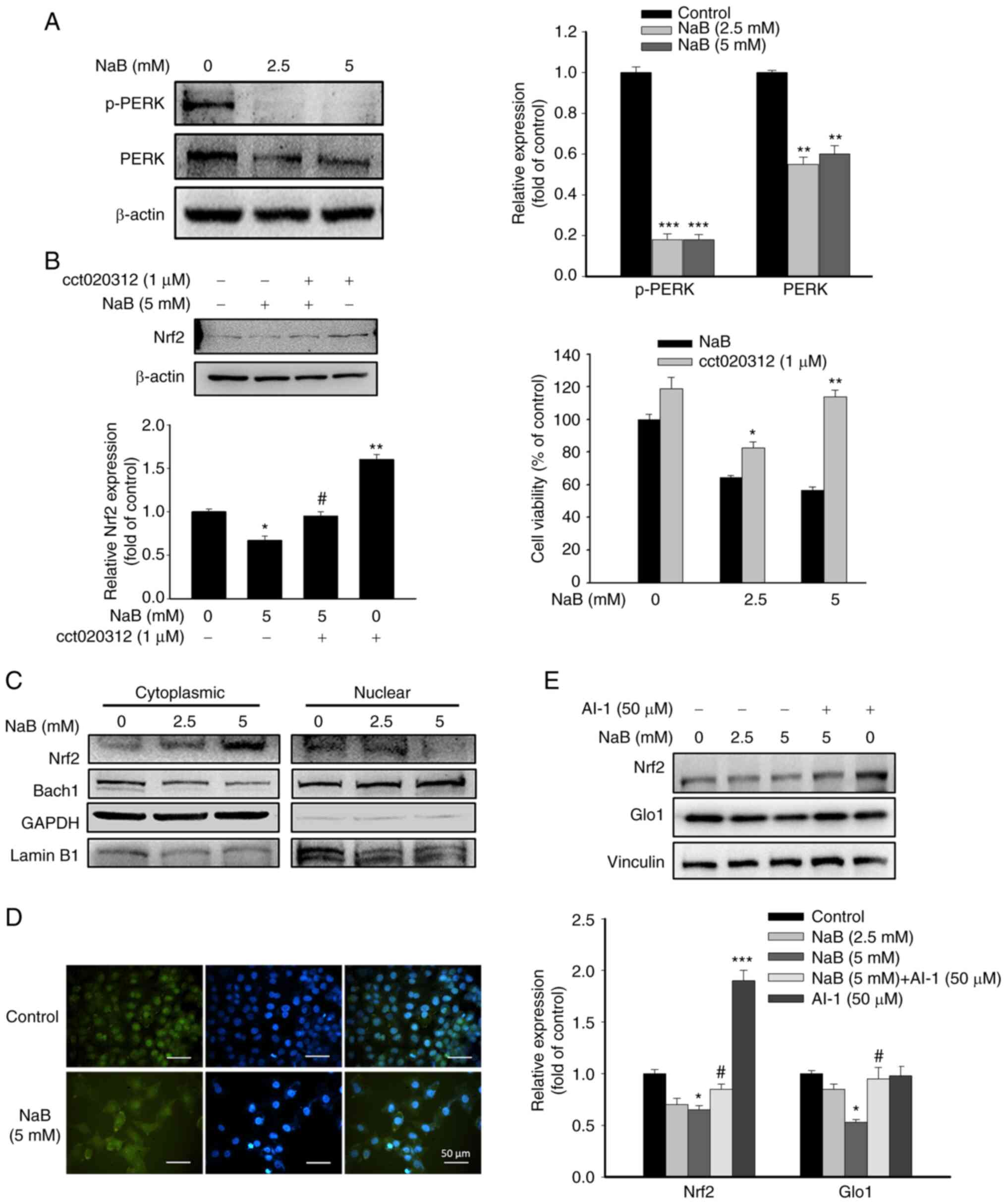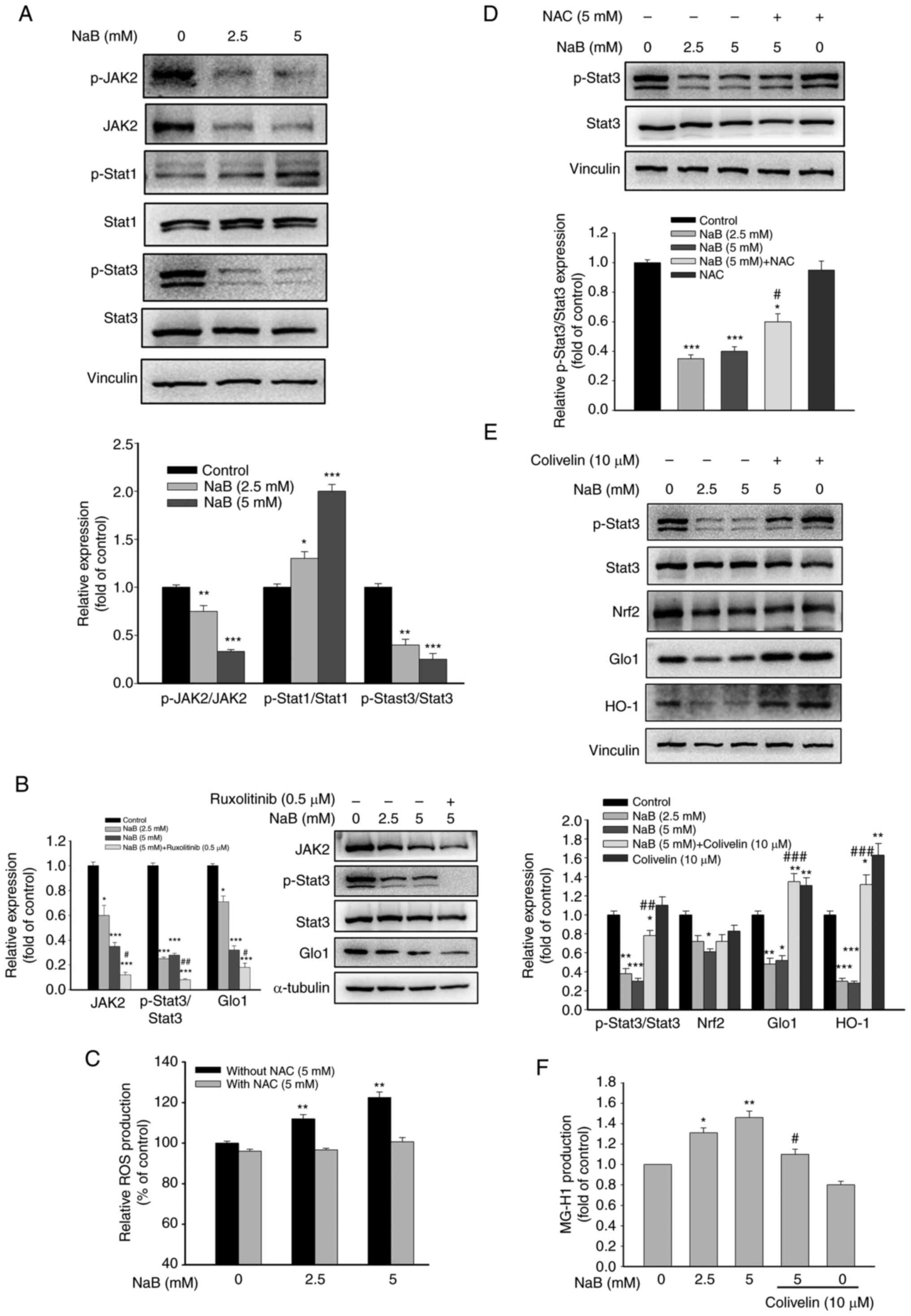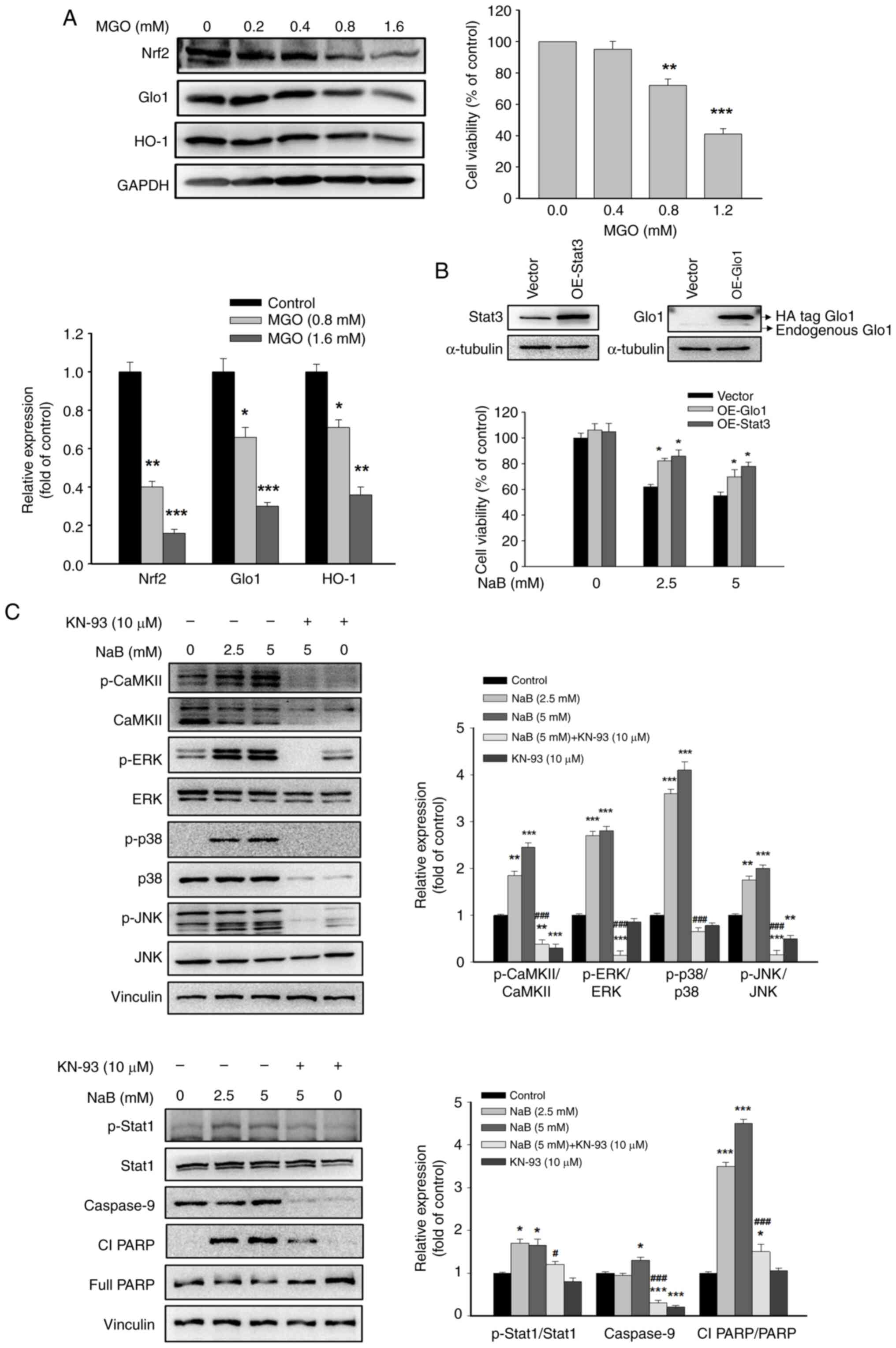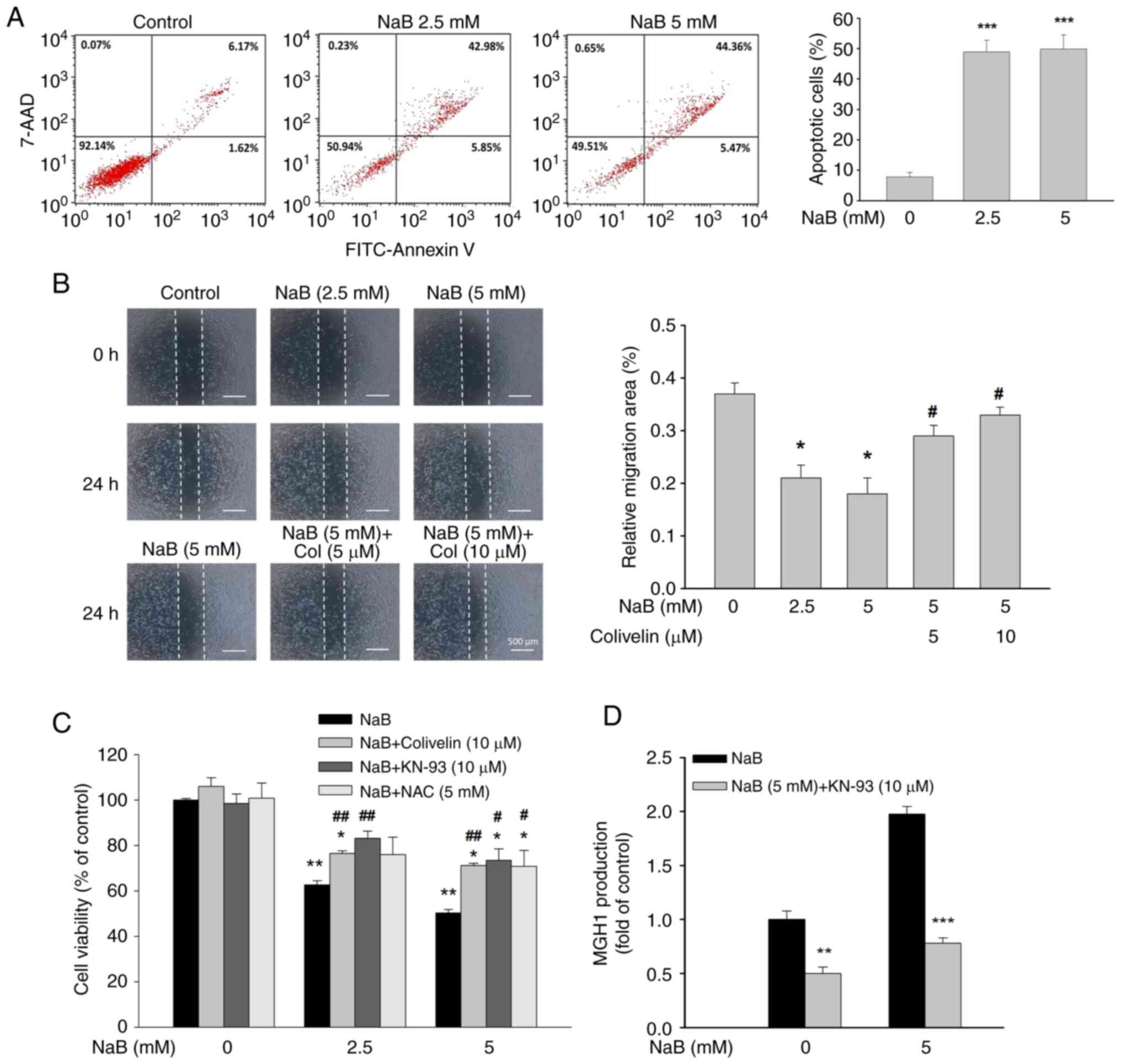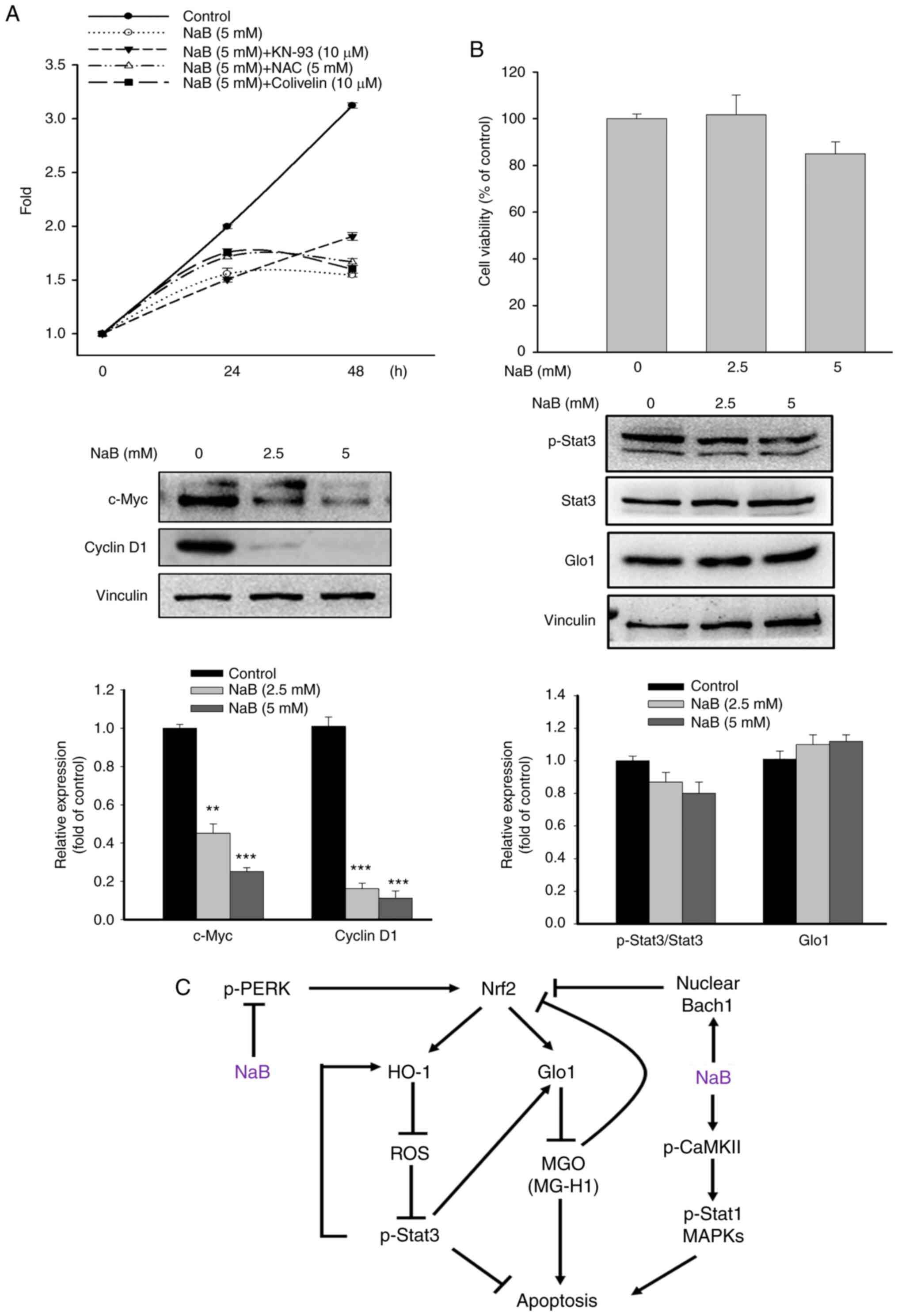|
1
|
Rawla P: Epidemiology of prostate cancer.
World J Oncol. 10:63–89. 2019. View Article : Google Scholar : PubMed/NCBI
|
|
2
|
Liberti MV and Locasale JW: The warburg
effect: How does it benefit cancer cells? Trends Biochem Sci.
41:211–218. 2016. View Article : Google Scholar : PubMed/NCBI
|
|
3
|
Monache SD, Pulcini F, Frosini R, Mattei
V, Talesa VN and Antognelli C: Methylglyoxal-dependent glycative
stress is prevented by the natural antioxidant oleuropein in human
dental pulp stem cells through Nrf2/Glo1 pathway. Antioxidants
(Basel). 10:7162021. View Article : Google Scholar
|
|
4
|
Milanesa DM, Choudhury MS, Mallouh C,
Tazaki H and Konno S: Methylglyoxal-induced apoptosis in human
prostate carcinoma: Potential modality for prostate cancer
treatment. Eur Urol. 37:728–734. 2000. View Article : Google Scholar : PubMed/NCBI
|
|
5
|
He Y, Zhou C, Huang M, Tang C, Liu X, Yue
Y, Diao Q, Zheng Z and Liu D: Glyoxalase system: A systematic
review of its biological activity, related-diseases, screening
methods and small molecule regulators. Biomed Pharmacother.
131:1106632020. View Article : Google Scholar : PubMed/NCBI
|
|
6
|
Antognelli C, Mezzasoma L, Fettucciari K,
Mearini E and Talesa VN: Role of glyoxalase I in the proliferation
and apoptosis control of human LNCaP and PC3 cells. Prostate.
73:121–132. 2013. View Article : Google Scholar : PubMed/NCBI
|
|
7
|
Sakamoto H, Mashima T, Kizaki A, Dan S,
Hashimoto Y, Naito M and Tsuruo T: Glyoxalase I is involved in
resistance of human leukemia cells to antitumor agent-induced
apoptosis. Blood. 95:3214–3218. 2000. View Article : Google Scholar : PubMed/NCBI
|
|
8
|
Pouremamali F, Pouremamali A, Dadashpour
M, Soozangar N and Jeddi F: An update of Nrf2 activators and
inhibitors in cancer prevention/promotion. Cell Commun Signal.
20:1002022. View Article : Google Scholar : PubMed/NCBI
|
|
9
|
Zhang HS, Du GY, Zhang ZG, Zhou Z, Sun HL,
Yu XY, Shi YT, Xiong DN, Li H and Huang YH: NRF2 facilitates breast
cancer cell growth via HIF1α-mediated metabolic reprogramming. Int
J Biochem Cell Biol. 95:85–92. 2018. View Article : Google Scholar : PubMed/NCBI
|
|
10
|
Xue M, Rabbani N, Momiji H, Imbasi P,
Anwar MM, Kitteringham N, Park BK, Souma T, Moriguchi T, Yamamoto M
and Thornalley PJ: Transcriptional control of glyoxalase 1 by Nrf2
provides a stress-responsive defense against dicarbonyl glycation.
Biochem J. 443:213–222. 2012. View Article : Google Scholar : PubMed/NCBI
|
|
11
|
Iurlaro R and Muñoz-Pinedo C: Cell death
induced by endoplasmic reticulum stress. FEBS J. 283:2640–2652.
2016. View Article : Google Scholar : PubMed/NCBI
|
|
12
|
Cullinan SB, Zhang D, Hannink M, Arvisais
E, Kaufman RJ and Diehl JA: Nrf2 is a direct PERK substrate and
effector of PERK-dependent cell survival. Mol Cell Biol.
23:7198–7209. 2003. View Article : Google Scholar : PubMed/NCBI
|
|
13
|
Fujiki T, Ando F, Murakami K, Isobe K,
Mori T, Susa K, Nomura N, Sohara E, Rai T and Uchida S: Tolvaptan
activates the Nrf2/HO-1 antioxidant pathway through PERK
phosphorylation. Sci Rep. 9:92452019. View Article : Google Scholar : PubMed/NCBI
|
|
14
|
Lee H, Jeong AJ and Ye SK: Highlighted
STAT3 as a potential drug target for cancer therapy. BMB Rep.
52:415–423. 2019. View Article : Google Scholar : PubMed/NCBI
|
|
15
|
Tian Y, Liu H, Wang M, Wang R, Yi G, Zhang
M and Chen R: Role of STAT3 and NRF2 in tumors: Potential targets
for antitumor therapy. Molecules. 27:87682022. View Article : Google Scholar : PubMed/NCBI
|
|
16
|
Antognelli C, Gambelunghe A, Talesa VN and
Muzi G: Reactive oxygen species induce apoptosis in bronchial
epithelial BEAS-2B cells by inhibiting the antiglycation glyoxalase
I defence: Involvement of superoxide anion, hydrogen peroxide and
NF-κB. Apoptosis. 19:102–116. 2014. View Article : Google Scholar : PubMed/NCBI
|
|
17
|
McCoy F, Eckard L, Chen SL and Nutt LK:
Metabolic regulation of apoptosis via Ca+/Calmodulin
Kinase II (CaMKII). BMC Proc. 6 (Suppl 3):P362012.
|
|
18
|
He Q and Li Z: The dysregulated expression
and functional effect of CaMK2 in cancer. Cancer Cell Int.
21:3262021. View Article : Google Scholar : PubMed/NCBI
|
|
19
|
Bridgeman SC, Northrop W, Melton PE,
Ellison GC, Newsholme P and Mamotte CDS: Butyrate generated by gut
microbiota and its therapeutic role in metabolic syndrome.
Pharmacol Res. 160:1051742020. View Article : Google Scholar : PubMed/NCBI
|
|
20
|
Chen J, Zhao KN and Vitetta L: Effects of
intestinal microbial-elaborated butyrate on oncogenic signaling
pathways. Nutrients. 11:10262019. View Article : Google Scholar : PubMed/NCBI
|
|
21
|
Gasparian A, Aksenova M, Oliver D, Levina
E, Doran R, Lucius M, Piroli G, Oleinik N, Ogretmen B, Mythreye K,
et al: Depletion of COPI in cancer cells: The role of reactive
oxygen species in the induction of lipid accumulation, noncanonical
lipophagy and apoptosis. Mol Biol Cell. 33:ar1352022. View Article : Google Scholar : PubMed/NCBI
|
|
22
|
Jaud M, Philippe C, Van Den Berghe L,
Ségura C, Mazzolini L, Pyronnet S, Laurell H and Touriol C: The
PERK branch of the unfolded protein response promotes DLL4
expression by activating an alternative translation mechanism.
Cancers (Basel). 11:1422019. View Article : Google Scholar : PubMed/NCBI
|
|
23
|
Hur W, Sun Z, Jiang T, Mason DE, Peters
EC, Zhang DD, Luesch H, Schultz PG and Gray NS: A small-molecule
inducer of the antioxidant response element. Chem Biol. 17:537–547.
2010. View Article : Google Scholar : PubMed/NCBI
|
|
24
|
Lv C, Huang Y, Wang Q, Wang C, Hu H, Zhang
H, Lu D, Jiang H, Shen R, Zhang W and Liu S: Ainsliadimer A induces
ROS-mediated apoptosis in colorectal cancer cells via directly
targeting peroxiredoxin 1 and 2. Cell Chem Biol. 30:295–307. 2023.
View Article : Google Scholar : PubMed/NCBI
|
|
25
|
Xie JR, Chen XJ and Zhou G: Nuciferine
inhibits oral squamous cell carcinoma partially through suppressing
the STAT3 signaling pathway. Int J Mol Sci. 24:145322023.
View Article : Google Scholar : PubMed/NCBI
|
|
26
|
Pattison MJ, Mackenzie KF and Arthur JS:
Inhibition of JAKs in macrophages increases
lipopolysaccharide-induced cytokine production by blocking
IL-10-mediated feedback. J Immunol. 189:2784–2792. 2012. View Article : Google Scholar : PubMed/NCBI
|
|
27
|
Mu D, Gao Z, Guo H, Zhou G and Sun B:
Sodium butyrate induces growth inhibition and apoptosis in human
prostate cancer DU145 cells by up-regulation of the expression of
annexin A1. PLoS One. 8:e749222013. View Article : Google Scholar : PubMed/NCBI
|
|
28
|
Zhang X, Guo J, Wei X, Niu C, Jia M, Li Q
and Meng D: Bach1: Function, regulation, and involvement in
disease. Oxid Med Cell Longev. 2018:13479692018. View Article : Google Scholar : PubMed/NCBI
|
|
29
|
Avalle L, Pensa S, Regis G, Novelli F and
Poli V: STAT1 and STAT3 in tumorigenesis: A matter of balance.
JAKSTAT. 1:65–72. 2012.PubMed/NCBI
|
|
30
|
Guo Y, Zhang Y, Yang X, Lu P, Yan X, Xiao
F, Zhou H, Wen C, Shi M, Lu J and Meng QH: Effects of methylglyoxal
and glyoxalase I inhibition on breast cancer cells proliferation,
invasion, and apoptosis through modulation of MAPKs, MMP9, and
Bcl-2. Cancer Biol Ther. 17:169–180. 2016. View Article : Google Scholar : PubMed/NCBI
|
|
31
|
Chen H, Liu H and Qing G: Targeting
oncogenic Myc as a strategy for cancer treatment. Signal Transduct
Target Ther. 3:52018. View Article : Google Scholar : PubMed/NCBI
|
|
32
|
Thulin MH, Määttä J, Linder A, Sterbova S,
Ohlsson C, Damber JE, Widmark A and Persson E: Inhibition of STAT3
prevents bone metastatic progression of prostate cancer in vivo.
Prostate. 81:452–462. 2021. View Article : Google Scholar : PubMed/NCBI
|
|
33
|
Kim SJ, Saeidi S, Cho NC, Kim SH, Lee HB,
Han W, Noh DY and Surh YJ: Interaction of Nrf2 with dimeric STAT3
induces IL-23 expression: Implications for breast cancer
progression. Cancer Lett. 500:147–160. 2021. View Article : Google Scholar : PubMed/NCBI
|
|
34
|
Rouillard AD, Gundersen GW, Fernandez NF,
Wang Z, Monteiro CD, McDermott MG and Ma'ayan A: The harmonizome: A
collection of processed datasets gathered to serve and mine
knowledge about genes and proteins. Database (Oxford).
2016:baw1002016. View Article : Google Scholar : PubMed/NCBI
|
|
35
|
Kim DH, Park KW, Chae IG, Kundu J, Kim EH,
Kundu JK and Chun KS: Carnosic acid inhibits STAT3 signaling and
induces apoptosis through generation of ROS in human colon cancer
HCT116 cells. Mol Carcinog. 55:1096–110. 2016. View Article : Google Scholar : PubMed/NCBI
|
|
36
|
Jagadeesh ASV, Fang X, Kim SH,
Guillen-Quispe YN, Zheng J, Surh YJ and Kim SJ: Non-canonical vs.
Canonical functions of heme oxygenase-1 in cancer. J Cancer Prev.
27:7–15. 2022. View Article : Google Scholar : PubMed/NCBI
|
|
37
|
Zhang J, Wang F, Liu F and Xu G:
Predicting STAT1 as a prognostic marker in patients with solid
cancer. Ther Adv Med Oncol. 12:17588359209175582020. View Article : Google Scholar : PubMed/NCBI
|
|
38
|
Regis G, Pensa S, Boselli D, Novelli F and
Poli V: Ups and downs: The STAT1:STAT3 seesaw of interferon and
gp130 receptor signalling. Semin Cell Dev Biol. 19:351–359. 2008.
View Article : Google Scholar : PubMed/NCBI
|
|
39
|
Wang G, Wang Y, Yang Q, Xu C, Zheng Y,
Wang L, Wu J, Zeng M and Luo M: Metformin prevents
methylglyoxal-induced apoptosis by suppressing oxidative stress in
vitro and in vivo. Cell Death Dis. 13:292022. View Article : Google Scholar : PubMed/NCBI
|
|
40
|
Timmins JM, Ozcan L, Seimon TA, Li G,
Malagelada C, Backs J, Backs T, Bassel-Duby R, Olson EN, Anderson
ME and Tabas I: Calcium/calmodulin-dependent protein kinase II
links ER stress with Fas and mitochondrial apoptosis pathways. J
Clin Invest. 119:2925–2941. 2009. View Article : Google Scholar : PubMed/NCBI
|
|
41
|
Yue J and López JM: Understanding MAPK
signaling pathways in apoptosis. Int J Mol Sci. 21:23462020.
View Article : Google Scholar : PubMed/NCBI
|
|
42
|
Xu R and Hu J: The role of JNK in prostate
cancer progression and therapeutic strategies. Biomed Pharmacother.
121:1096792020. View Article : Google Scholar : PubMed/NCBI
|
|
43
|
Kanzaki H, Shinohara F, Itohiya K,
Yamaguchi Y, Katsumata Y, Matsuzawa M, Fukaya S, Miyamoto Y, Wada S
and Nakamura Y: RANKL induces Bach1 nuclear import and attenuates
Nrf2-mediated antioxidant enzymes, thereby augmenting intracellular
reactive oxygen species signaling and osteoclastogenesis in mice.
FASEB J. 31:781–792. 2017. View Article : Google Scholar : PubMed/NCBI
|
|
44
|
Harris WP, Mostaghel EA, Nelson PS and
Montgomery B: Androgen deprivation therapy: Progress in
understanding mechanisms of resistance and optimizing androgen
depletion. Nat Clin Pract Urol. 6:76–85. 2009. View Article : Google Scholar : PubMed/NCBI
|
|
45
|
Chandrasekar T, Yang JC, Gao AC and Evans
CP: Mechanisms of resistance in castration-resistant prostate
cancer (CRPC). Transl Androl Urol. 4:365–380. 2015.PubMed/NCBI
|



